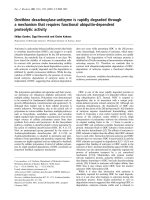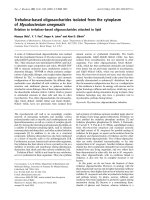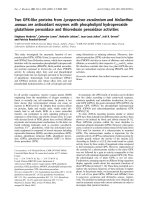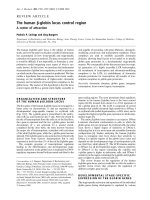Báo cáo y học: " Osteolytic bone destruction resulting from relapse of a testicular tumour 23 years after inguinal orchiectomy and adjuvant chemotherapy: a case report" pot
Bạn đang xem bản rút gọn của tài liệu. Xem và tải ngay bản đầy đủ của tài liệu tại đây (1.11 MB, 4 trang )
Case report
Open Access
Osteolytic bone destruction resulting from relapse of a testicular
tumour 23 years after inguinal orchiectomy and adjuvant
chemotherapy: a case report
Christos Kalaitzis*, Ath anasios Bantis, Georgios Tsakaldimis,
Stylianos Giannakopoulos, Efthimios Sivridis and Stavros Touloupidis
Address: Department of Urology, Democritus University of Thrace, Alexandroupolis, Greece
Email: CK* - ; AB - ; GT - ; SG - ;
ES - ; ST -
* Corresponding author
Received: 22 September 2008 Accepted: 8 May 2009 Published: 31 July 2009
Journal of Medical Case Reports 2009, 3:8702 doi: 10.4076/1752-1947-3-8702
This article is available from: />© 2009 Kalaitzis et al.; licensee Cases Network Ltd.
This is an Open Access article distributed under the terms of the Creative Commons Attribution License (
/>which permits unrestricted use, distribution, and reproduction in any medium, provided the original work is properly cited.
Abstract
Introduction: Late relapse of a testicular germ cell tumour is an uncommon occurrence. We
report a case of osteolytic bone metastasis appearing 23 years after the initial treatment of
a metastatic testicular mixed tumour (choriocarcinoma and embryonal carcinoma). This is one of the
longest periods of recurrence reported for testicular germ cell tumours.
Case presentation: A 52-year-old Caucasian man who underwent a right inguinal orchiectomy due
to testicular tumour in 1984 presented to our outpatient clinic in a generally bad condition of health
and with severe pain of his right hip joint and os ischii caused by osteolytic metastasis.
Conclusions: This case emphasizes the need for a life-long follow-up of patients with primary
metastatic testicular cancer.
Introduction
The prognosis of malignant testicular tumour has drama-
tically improved due to cisplatin-based chemotherapy.
When diagnosed at an early stage, the disease has a cure
rate of 95% to 100%. In advanced stages, cure rates of up
to 70% are still possible [1]. However, after surgical
therapy and cisplatin containing chemotherapy, up to
10% of patients monitored have developed relapses
despite being pronounced tumour-free. The majority of
these relapses developed during the first two years [2].
However, in a small number of patients, late relapses
were noted [2].
The most complete report of late relapse was published by
Baniel et al. [3]. The authors demonstrated that germ cell
tumours in a situation of late relapse exhibit a biological
behaviour that is different from the primary tumours. An
early relapse incidence of 2% to 3% was calculated. The
median time of appearance for late relapse was six years,
and the main localisation was the retroperitoneum and
Page 1 of 4
(page number not for citation purposes)
the lung, following an increase in the level of the tumour
marker alpha-fetoprotein (AFP). Late relapse was sensitive
to chemotherapy, although chemotherapy alone is
normally insufficient to achieve a complete cure. The
most efficacious therapy was surgical resection of the
tumour mass.
We report here a case of a late relapse of a germ cell
tumour, which occurred 23 years after orchiectomy and
following four cycles of chemotherapy and five years of
complete remission.
Case presentation
A 52-year-old man presented to our outpatient clinic in
a bad general condition of health and with severe pain of
his right hip joint and os oschii. The pain developed
approximately three months prior to presentation.
The patient’s medical history revealed a right inguinal
orchiectomy for the removal of testicular tumour per-
formed in France in 1984. The rest of his anamnesis was
clinically insignificant.
In 1984, the patient’s histopathology revealed a mixed
tumour, a choriocarcinoma and an embryonic carcinoma,
with retroperitoneal and pulmonary metastases. To treat
this, an orchiectomy was performed, followed by four
cycles of bleomycin, etoposide and cisplatin (BEP)
chemotherapy. Follow-up assessments were initially per-
formed at an interval of three months, and then at an
interval of six months until the fifth postoperative year.
When the patient presented to our clinic, he appeared to be
in bad general health, with severe pain in his right hip joint.
His serum level of alpha-fetoprotein was 169.48 ng/ml
(normal range 0.0 to7.0 ng/ml) and beta-human chorionic
gonadotropin (ß-hCG) was 1.30 mIU/ml (normal range
<5.0 mIU/ml). The patient’s lactate dehydrogenase (LDH)
level was 1155 U/L (normal range 230 to 460 U/L) and his
alkaline phosphatase level was 104 U/L (normal range is
3 to 128 U/L).
Radiological investigation, which was later confirmed
through computer tomograms, demonstrated that there
was an osteolytic destruction of the patient’s os ischii and
hip joint (Figure 1). In addition, enlarged lymphatic nodes
were found on the patient’s retroperitoneal space. Two
pulmonary metastases were also found in his left lung
(Figure 2).
A biopsy of the lytic bone lesion was carried out to confirm
the diagnosis. Histological and immunohistochemical
investigation of the biopsy cylinders showed an anaplastic
seminoma (Figure 3). Immunohistochemical testing was
positive for alpha-fetoprotein but negative for hCG,
carcinoembryonic antigen (CEA), CD30 and CD117
(C kit).
Due to strong pain, analgesia with peripheral and central
analgesics was initiated. During the next three days,
however, the state of our patient dramatically declined
and he died a day before the results of the biopsy were
known.
Discussion
After initial therapy, patients with germ cell tumours who
have two years of complete remission have a high cure
rate. The probability of a late relapse is between 1.3% and
7% [4-6]. Late relapses of nonseminomatous tumours are
more frequent [4].
Late relapse is defined as a germ cell tumour that appears
more than two years after therapy and complete remission
[3]. Of the 81 patients treated at the University of Indiana
for late relapse of germ cell tumours, 60% showed late
relapse more than five years after primary therapy and
complete remission [3].
A series of 1263 patients with germ cell testicular tumour
treated at the Department of Radiotherapy and Oncology
in Surrey, United Kingdom showed that only 14 patients
had late relapse between the 5th and 10th year after
primary treatment with a calculated annual risk of 1%. In
two patients, late relapse occurred later than 10 years. One
of these patients presented with metastatic seminoma,
while the other presented with nonseminoma during
the clinical stage I, which was then followed up by a wait-
and-see attitude [7].
Figure 1. Osteolytic destruction of the patient’s right os
ischii.
Page 2 of 4
(page number not for citation purposes)
Journal of Medical Case Reports 2009, 3:8702 />The possible mechanisms for the development of late
relapses are identified as: 1) the presence of mature
teratoma in the germ cell tumour; 2) the growth of the
remaining tumour not destroyed by the chemotherapy;
and 3) the development of a secondary germ cell
carcinoma and the microscopic persistence of tumour
cells with atypical biological behaviour [8].
Albers et al. wrote the European Association of Urology
(EAU) guidelines on testicular cancer in a limited update
in March 2009. Precise recommendations for minimum
follow-up schedules in advanced nonseminomatous germ
cell tumours and seminoma were provided, indicating the
procedures that should be performed at one, two and three
to five years after initial therapy and thereafter [9].
Late relapses respond weakly to chemotherapy. Surgical
excision remains the best treatment. Baniel et al. showed
that chemotherapy alone yields poor results in patients
with late relapse [3]. Tumour-free status was achieved by
chemotherapy in only two out of 81 patients. In patients
who did not initially receive chemotherapy to treat the
germ cell tumour, complete remission could be reached
during late relapse by chemotherapy alone [3].
Conclusions
Late relapse of malignant germ cell tumours are a rare
occurrence. Until recently, it was generally considered
sufficient to perform follow-up assessments for up to five
years after initial therapy. However, metastatic nonsemi-
nomatous tumours form an exception to this general rule,
and late tumour relapses do occur. It thus seems necessary
that follow-up examinations be performed for longer than
five years after the primary therapy. This regime is
recommended in the latest 2009 update of the EAU
guidelines on testicular cancer as written by Albers and his
co-authors.
Abbreviations
AFP, alpha-fetoprotein; BEP, bleomycin, etoposide and
cisplatin; CEA, carcinoembryonic antigen; EAU, European
Association of Urology; hCG, Human chorionic gonado-
tropin; LDH, lactate dehydrogenase.
Consent
We were unable to obtain consent for the publication of
this case due to the death of the patient and despite
repeated attempts we were unable to trace the next of kin.
Every effort has been made to keep the patient’s identity
anonymous. We would not expect the patient’s family to
object to publication.
Competing interests
The authors declare that they have no competing interests.
Authors’ contribution
GS and TG performed the bone biopsy. SE performed the
histological examination. BA was a major contributor in
writing the manuscript. All authors read and approved the
final manuscript.
References
1. Einhorn LH: Treatment of testicular cancer: a new and
improved model. J Clin Oncol 1990, 8:1777-1781.
2. George DW, Foster RS, Hromas RA, Robertson KA, Vance GH,
Ulbricht TM, Gobett TA, Heiber DJ, Heerema NA, Ramsey HC,
Figure 3. Bone biopsy with a focus of metastatic germ cells
with abundant clear or weakly eosinophilic cytoplasm
(Haematoxylin and eosin).
Figure 2. CT scan of the chest shows a tumour mass in the
left lung.
Page 3 of 4
(page number not for citation purposes)
Journal of Medical Case Reports 2009, 3:8702 />Thurston VC, Jung SH, Shen J, Finch DE, Kelley MR, Einhorn LH:
Update on Late Relapse of Germ Cell Tumor: A Clinical and
Molecular Analysis. J Clin Oncol 2003, 21:113-122.
3. Baniel J, Foster RS, Gonin R, Messemer JE, Donohue JP, Einhorn LH:
Late relapse of testicular cancer. J Clin Oncol 1995, 13:1170-1176.
4. Lipphard ME, Albers P: Late relapse of testicular cancer. World J
Urol 2004, 22:47-54.
5. Clemm GA, Schmeller N, Hentrich M, Lamerz R, Willmanns W: Late
relapse of germ cell t umours after cisplatin-based
chemotherapy. Ann Oncol 1997, 8:41-47.
6. Oldenburg J, Alfsen GC, Waehre H, Fossa SD: Late recurrences of
germ cell malignancies: a population-based experience of
over three decades. Br J Cancer 2006, 94:820-827.
7. Shahidi M, Norman AR, Dearnaley DP: Late recurrence in 1263
men with testicular germ cell tumours. Multivariant analysis
of risk factors and implications for management. Cancer 2002,
95:520-530.
8. DeLeoMJ,GrecoFA,HainsworthJD,JohnsonDH:Late
recurrence in long-term survivors of germ cell neoplasms.
Cancer 1988, 62:985-988.
9. Albers P, Albrecht W, Algaba F, Bokemeyer C, Cohn-Cedermark G,
Horwich A, Klepp O, Laguna MP, Pizzocaro G: Guidelines on
Testicular Cancer. Eur Urol 2005, 48:885-894.
Do you have a case to share?
Submit your case report today
• Rapid peer review
• Fast publication
• PubMed indexing
• Inclusion in Cases Database
Any patient, any case, can teach us
something
www.casesnetwork.com
Page 4 of 4
(page number not for citation purposes)
Journal of Medical Case Reports 2009, 3:8702 />








